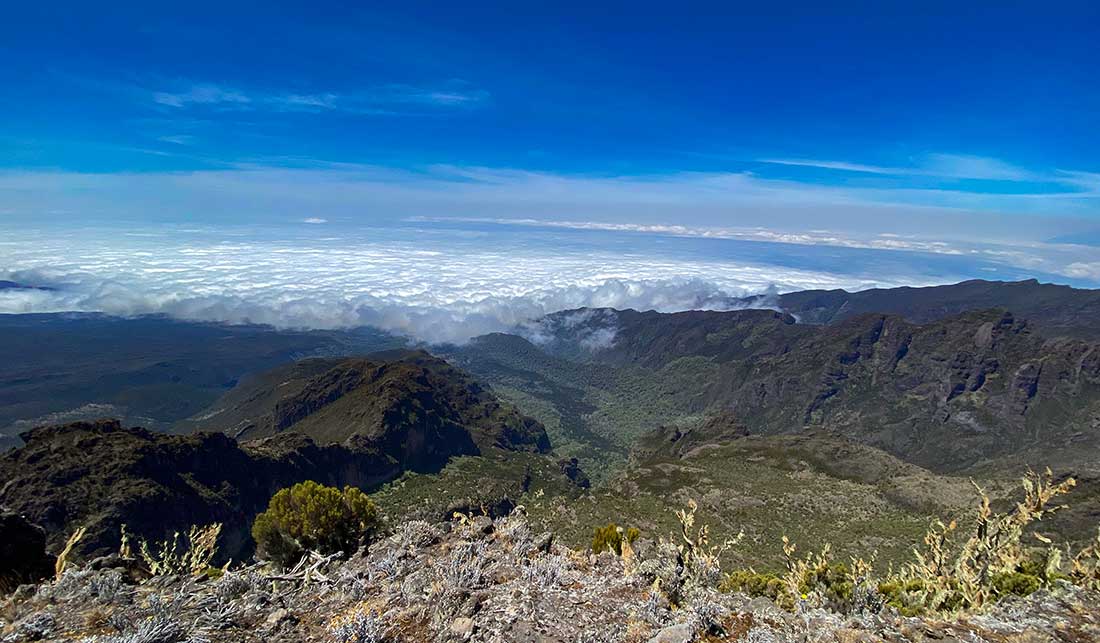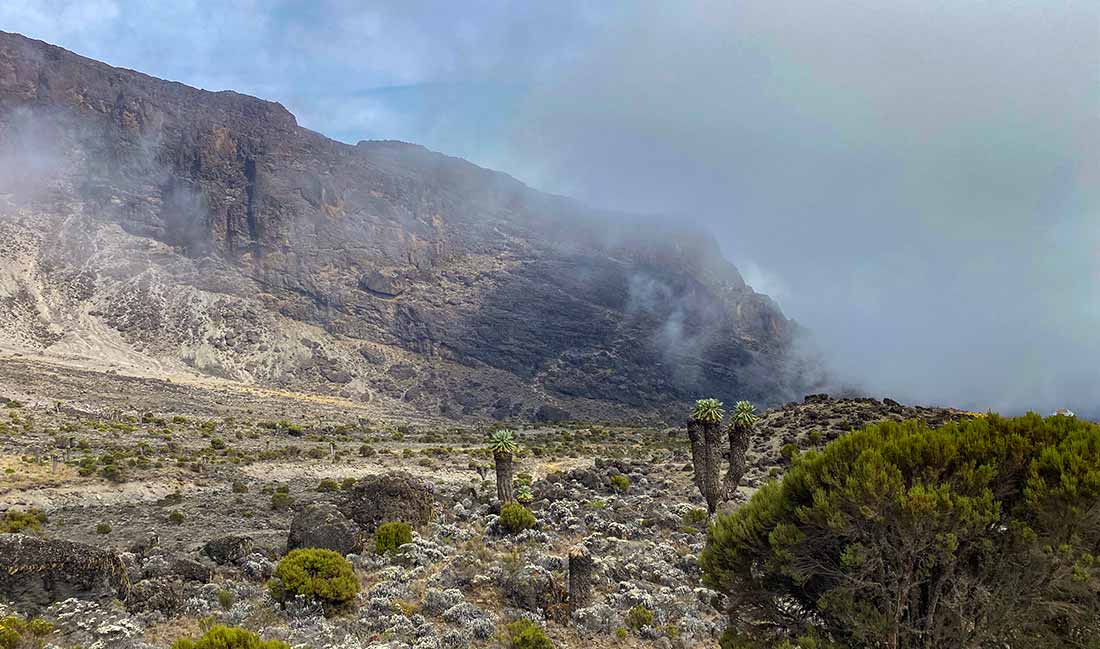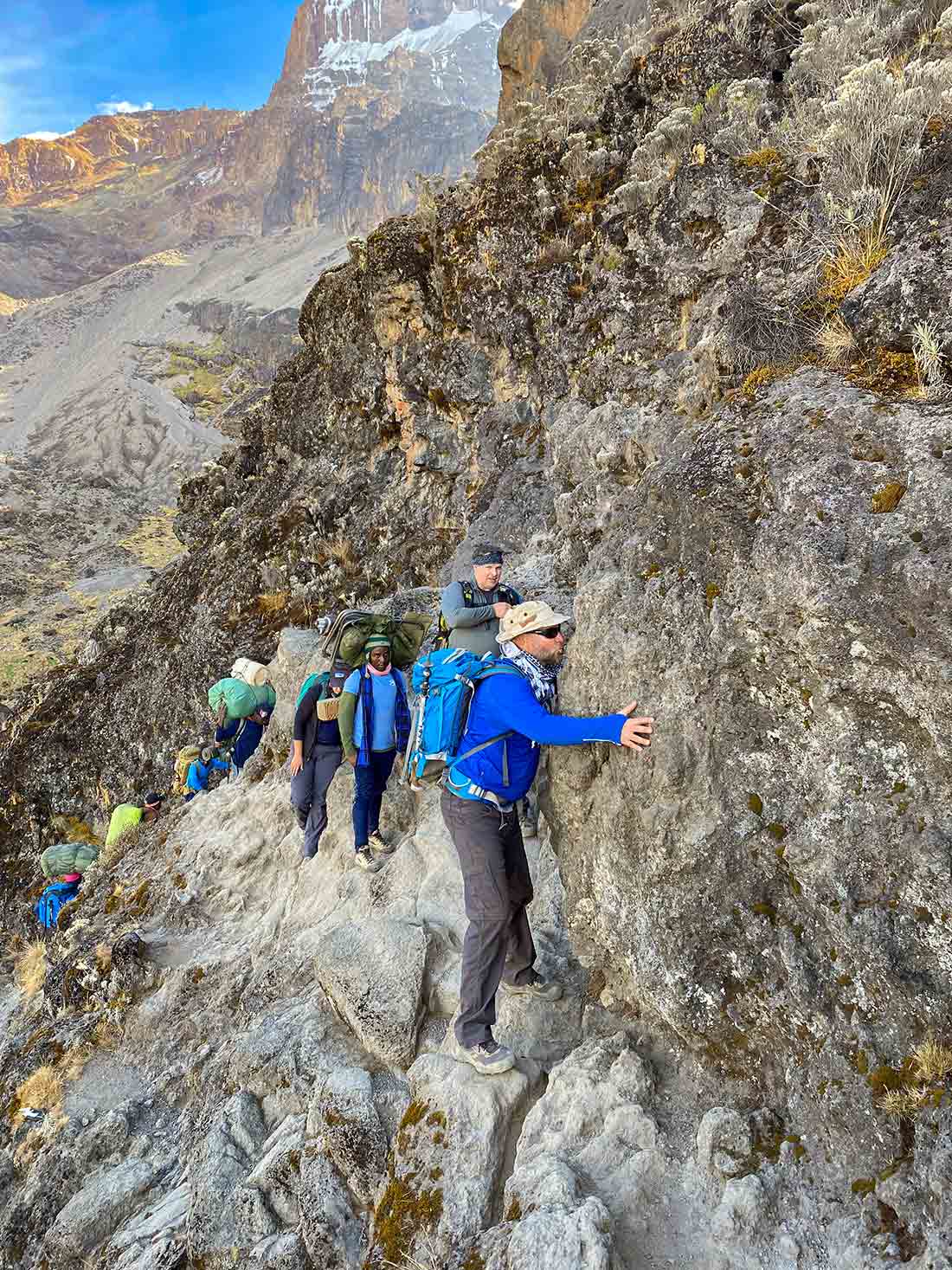The simple answer is yes, you can climb Kilimanjaro if you are afraid of heights. But what does your fear of heights consist of? Do you get woozy looking down from a tall spot? Do you suffer from vertigo? Did a childhood trauma, like falling out of a tree affect your adult life and your fear of being up high?
Let’s delve into these and see how they may change your perception of climbing Kilimanjaro.
First of all, the fear of heights is Acrophobia. Researchers aren’t sure what exactly causes one to have a fear of heights. They believe that having acrophobia can stem from our natural human concern of falling from a high place and hurting ourselves. Dwelling on and worrying about the possible pain you could experience from falling from a significant height could contribute to developing acrophobia.
Researchers also think that a negative or traumatic experience that involved a significant height may contribute to a person developing acrophobia.
There is nothing on the mountain that will stop you from reaching the summit if the only obstacle is your fear of heights. There are a few areas that may make you feel a bit uneasy, but you can choose a different route, one that avoids the more difficult spots. Another option is to face your fears and try to overcome them.
Personal Experience
We interviewed our Managing Partner, Dana Wentzel. He used to have a fear of heights.
His fear of heights was a direct result of falling out of a tree, about 30 feet when he was just eight years old.
Wentzel was trying to climb up into an old tree house in the woods where he lived. When he was almost there, the branch he was holding on to broke and he fell. He remembers falling long enough to see that his fall will result in either landing on an old pile of wood with nails or if he went the other way, falling into a large patch of stinging nettles. Both appeared unpleasant.
However, his fall was interrupted by his younger brother (age 6) that tried to catch him. He impacted with his brother’s shoulder and ricocheted onto the pile of boards.
Of course, his father being former military chose not to take him to the hospital. Instead, used a 2×4 and hammer propped against his leg to remove the nails from the bone.
This childhood trauma definitely left a lasting impression on him.
But, his fear of heights was cured as a young man in the United States Marine Corps bootcamp. It was on the 70-foot rappelling tower that he faced his fears and rappelled off as a Drill Instructor screamed, “Get off my tower!”
He did and then some. Wentzel overcame his fear. He now finds rappelling, in the middle of nowhere a passion. His hobby—called canyoneering—consists of hiking, rappelling, stemming, and swimming. Depending on the canyon, sometimes he carries overnight and pack rafting equipment. His longest rappel to date is 410 feet in a remote side canyon into Grand Canyon.

See some of his canyoneering videos here: https://www.youtube.com/channel/UCC4uZvlLl4ILVozZg_RsH3Q
If Wentzel can overcome his fears then so can you. That is unless you have an actual illness such as vertigo.
Vertigo
To be clear, vertigo isn’t an illness, but rather a symptom of an illness.
Vertigo is the sensation that you, or the environment around you, are moving or spinning. This feeling may not be very noticeable, or it may be severe enough that you find it difficult to keep your balance and do everyday tasks.
Attacks of vertigo can develop suddenly and last for a few seconds, or much longer. If you have severe vertigo, your symptoms may be constant and last for several days, making normal life very difficult.
Other symptoms associated with vertigo may include:
loss of balance – which can make it difficult to stand or walk
feeling sick or being sick
dizziness
Vertigo is a disruption of balance. This balance is controlled by the inner ear. Certain parts of the brain can also lead to vertigo.
Causes of vertigo may include:
- Benign paroxysmal positional vertigo (BPPV) – where certain head movements trigger vertigo
- Migraines – severe headaches
- Labyrinthitis – an inner ear infection
Vestibular neuronitis – inflammation of the vestibular nerve, which runs into the inner ear and sends messages to the brain that help to control balance
Depending on the condition causing vertigo, you may experience additional symptoms, such as a high temperature, ringing in your ears (tinnitus), and hearing loss.
If you suffer from any of these symptoms, then we recommend making an appointment with your General Practitioner. If not, then climbing Kilimanjaro should not be difficult from a fear of heights standpoint.
Other Considerations
Furthermore, if you still suffer from a fear of heights and vertigo or childhood trauma are not to blame and you don’t have a drill instructor yelling at you, what can you do if you still want to climb Kilimanjaro?
The answer is to pick a route that doesn’t go up the lookout points like Shira Cathedral or climb the Barranco Wall.
Both of these are on the Lemosho Route. The Northern Circuit route only goes to the Shira Cathedral and the Machame route only goes to the Barranco Wall. So if all three of these are out, then what is left? First, let’s talk about each of the obstacles before we give you that answer.
Shira Cathedral

The first and less formidable obstacle is the Shira Cathedral. You will visit this location on both the Lemosho and the Northern Circuit routes. It is an acclimating hike that ends up at an elevation of about 12,800 ft. From the top, you will be treated to amazing views of the rainforest clouds below with Mount Meru appearing to float on these clouds. For what it is worth it is one of the most scenic spots on the mountain. The Shira Cathedral peak is optional. You can climb as high as you feel comfortable since it is an out-and-back trail.
Barranco Wall

The real obstacle for those who suffer from a fear of heights is the infamous Barranco Wall. It stands 800 ft tall and is quite intimidating at first glance. As you descend into the Barranco Valley on your way to Barranco Camp, it looms menacingly to the East. When you first look at it, it appears to be impassable. The trail obscured from your vision by distance and clouds that continually roll through the Barranco Valley. It is truly quite stunning to behold. You will camp at its base for the night. The Barranco Camp is quite large and both the Lemosho and Machame routes have trekkers camp here. There are many people in the valley and all of them have to go up the Wall in the morning. Do not fear, if you listen to your guide, and pay attention to the trail, you should have no problem ascending the Barranco Wall.
Kissing Rock

Finally, there is one last obstacle that you’ll have to deal with and that is the Kissing Rock. In the photo, there is one section of the Barranco Wall that deserves mentioning all on its own. This section can lead to a bit of anxiety. Just hug (and kiss) the rock and step over the exposed section. There have been no reported accidents at this location so, again, listen to your guide and you’ll be fine.
Of note, this section is where a major backup of trekkers happens since you have to go one at a time. If you are on a private climb, you can talk to your guide about either leaving earlier or later than the crowd to avoid the bottleneck at Kissing Rock.
Other Routes
Still not convinced? Don’t worry, there are still two routes that you can take that do not have any exposed sections. They are the Rongai route, which is the easiest most gradual approach to the summit, and the Marangu route.
Final Thoughts
Now that we have dispelled your fears about the heights on Kilimanjaro, Are you ready to test your limits and see if you can climb Kilimanjaro if you are afraid of heights? We think you can. Our guides will be with you every step of the way to ensure that you are safe and as comfortable as possible. We want you to make your dream of climbing Kilimanjaro a reality.





